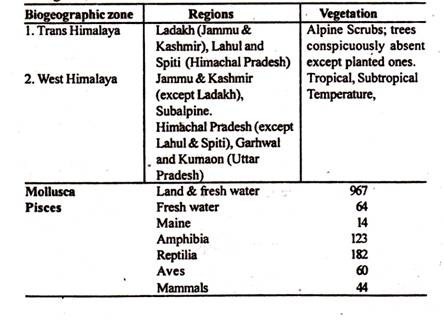Definition:
The living world is a complex combination of different levels of organisms. The key components of life are at one extreme and communities of species at the other extreme. The manifestations of all types of diversities are found at all these levels of organisms. Biodiversity is the shorter form of word biological diversity which means diversity in the biological world. Thus one can define biodiversity as the degree of variety in nature with regards to biological species.
Types of Biodiversity:
(a) Genetic diversity:
It is the variation of genes within the species. This results distinct population of one, even same species. It gives genetic variation within a population or varieties within one species. There are two reasons for differences between individual organisms. One is variation in the gene which all organisms possess which is passed from one to its offspring’s.
The other is the influence of environment on each individual organism. The variation in the sequence of four base pairs in DNA chain forms the genetic variation in the organism. The recombination) of genetic material during cell division makes it an imperative for genetic diversity within a species. Loss of genetic diversity within a species is called genetic erosion.
The whole area of agricultural productivity and development depend on genetic diversity. The plant as well as animal genetic resources play important role in the economy of a country. Genetic diversity is the whole basis for a sustainable life system in the earth.
Scientists in many parts of the world are trying to introduce genetically modified seeds in the agriculture sector for better yield as well as for the resistance of drought and flood situations. The local people or farmers are not showing any interest to preserve the natural way of genetic diversity.
(b) Species diversity:
This refers to the variety of species within a particular region. The number of species in a region is a measure for such diversity. The richness of species in a given region provides a yard stick for species diversity. Species diversity depends as much on the genetic diversity as on the environmental condition.
Colder regions support less than the warmer regions for species diversity. The good climate with good physical geography supports a better species diversity. Species richness is a term which is used to measure the biodiversity of a given site.
In addition to species richness, species endemism is a term used to measure biodiversity by way of assessing the magnitude of differences between species. In the taxonomic system similar species are grouped together in general, similar genera in families, families in orders and so on till in the level of kingdom. This process is a genuine attempt to find relationships between organisms. The higher taxa have thousands of species. Species that are very different from one another contributes more to overall biodiversity.
(c) Ecological diversity:
This is the number of species in a community of organisms. Maintaining both types of diversity is fundamental to the functioning of ecosystems and hence to human welfare. India is one of the 12 centres of diversity and origin of several cultivated plants in the world. It is estimated that 15,000 species of plants occur in India. The flowering plants comprise 15,000 species of which several hundred (5000-7500) species are endemic to India. The region is also rich in fauna, containing about 65,000 species of animals.
Among these, more than 50,000 species of insects, 4,000 of molluscs. 6,500 of other invertebrates, 2,000 offish, 140 of amphibians, 420 of reptiles, 1,200 of birds and 340 of mammals are recorded from India. This richness in biological diversity is due to immense variety of climatic and altitudinal conditions coupled with varied ecological habitats.
These vary from the humid tropical Western Ghats to the hot desert of Rajasthan, from the cold desert of Ladakh and the icy mountains of Himalayas to the warm coasts of peninsular India including coastal region of Orissa. Gandhamardan Hills of Sambalpur is rich in biodiversity. The Indian tradition teaches us that all forms of life, human, animal and plants are so closely linked that disturbance in one gives rise to imbalance in the other. Our old scriptures tell lot about these things.
Bio-geographical Classification of India:
Biogeography or biological geography is related to ecology and ecosystem of a region. Its studies include variation of flora and fauna over the earth surface. It also encompasses study of biosphere and its interaction with human population. Biogeography studies consider phytogeography (forest), zoogeography (animals, insects), pedology (soil) hydrology (water), oceanography (ocean).
The following is the Bio geographic zones of India and the types of vegetation found:
Many of the endangered and endemic species need human intervention for survival. Indian Government through various projects is trying to check this process of endangering of species.

